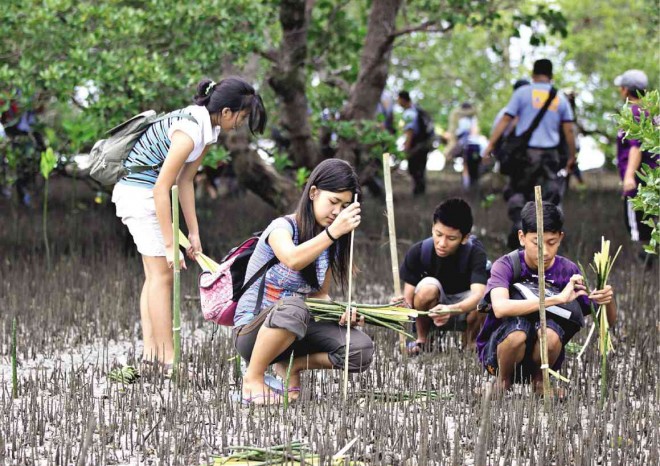
GREEN COVER Young people join the planting of mangrove propagules as part of efforts of the Quezon provincial government to transform open beaches into thick forests to protect inland communities from storm surges. More than two million mangroves were planted by the provincial government in 2012. DELFIN T. MALLARI JR.
With the devastation wrought by Supertyphoon “Yolanda” in Eastern Visayas last year serving as a grim reminder to pursue disaster-preparedness measures, Quezon’s provincial government is transforming coastal areas into “beach forests” to shield inland communities from storms and sea surges.
“With the deadly effects of climate change, particularly on our seas, we have to fortify our coastal areas to provide protection to our coastal residents,” Gov. David Suarez said.
The beach forest project is now being implemented in the province’s 1,066-kilometer coastline under the joint efforts of different local offices, with the Quezon Environment and Natural Resources Office (Quezon-Enro) as lead agency.
Thirty-four of Quezon’s 42 towns are coastal—17 along the Lamon Bay in the Pacific Ocean; 12 in the Tayabas Bay, facing the China Sea; and five in the Ragay Gulf.
“Aside from mangroves, the coastal communities are now planting talisay, ipil, dangkalang and other (hardwood) tree seedlings that are capable of withstanding storm surges,” Manny Calayag, Quezon-Enro deputy head, said in an interview on Saturday.
Although his office has yet to determine the exact distance of the beach forest from the shore, it will be built in the coastal area to conform with the 40-meter no-build zones being enforced by the national government in the wake of the massive destruction wrought by Yolanda across central Philippines.
Calayag said the provincial government would also conduct massive bamboo planting to protect critical areas from howling winds during typhoons.
Suarez, in an interview on Monday, explained that transforming the open beaches into thick forests of different species of robust trees would significantly support the protective cover of the more than two million mangroves that the provincial government planted in 2012.
The mangrove trees now measure an average height of more than three feet, Calayag said.
“The mangroves are being taken care of by the people. With what happened in the Visayas, they realized its importance to their safety and to their livelihood,” he said.
Suarez said the widespread devastation in Tacloban City, Leyte, Samar and other provinces at the height of Yolanda’s fury had jolted the whole country about the threat posed by the abnormal rising of the sea during typhoons.
The Quezon Provincial Disaster Risk Reduction Management Council has also strengthened the capabilities of the people against calamities, while its search and rescue unit has been providing training sessions and seminars in different parts of the province, he said.
Earlier, Henry Buzar, council officer, said the province had several tragic experiences with storm surges and monster typhoons. It even held the record for the highest death toll in the Calabarzon region, he noted.
As a safety measure against storm surges, Buzar recommended the construction of “bunker-like evacuation structures” on higher ground for residents of coastal villages.